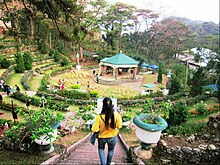
Baguio, officially the City of Baguio, is a 1st class highly urbanized city in the Cordillera Administrative Region, Philippines. It is known as the "Summer Capital of the Philippines", owing to its cool climate since the city is located approximately 4,810 feet above mean sea level, often cited as 1,540 meters in the Luzon tropical pine forests ecoregion, which also makes it conducive for the growth of mossy plants, orchids and pine trees, to which it attributes its other moniker as the "City of Pines".

Taguig, officially the City of Taguig, is a coastal city located in eastern shores of Metro Manila. It is the fifth-most populous city in the Philippines with a population of 1.2 million people. The city is one of the Philippines' cultural, financial, high-tech, entertainment and media centers with significant influence on commerce, health care, research, technology, education, politics, tourism, dining, art, fashion, and sports. Taguig is also an important center for the country's international diplomacy, hosting several embassies. The city also home to the headquarters of several major multinational corporations. Taguig has the fourth largest skyline in the Philippines, with 289 high-rises, 80 of which exceed 100 m (328 ft).
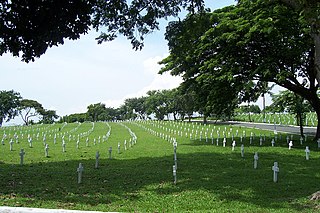
Libingan ng mga Bayani is a national cemetery within Fort Bonifacio in Taguig, Philippines.

Capas, officially the Municipality of Capas, is a 1st class municipality in the province of Tarlac, Philippines, and one of the richest towns in the province. The town also consists of numerous subdivisions and exclusive villages.

The Manila massacre, also called the Rape of Manila, involved atrocities committed against Filipino civilians in the City of Manila, the capital of the Philippines, by Japanese troops during the Battle of Manila which occurred during World War II. At least 100,000 civilians were killed in total during the battle from all causes including the massacre by Japanese troops.

Bonifacio Global City is a financial business district in Taguig, Metro Manila, Philippines. It is located 11 kilometers (6.8 mi) southeast of the capital city of Manila. The district experienced commercial growth following the sale of a 440 ha military base at Fort Bonifacio by the Bases Conversion and Development Authority (BCDA). The entire district used to be the part of the main Philippine Army camp.

John Hay Air Station, more commonly known as Camp John Hay, was a military installation in Baguio, Philippines.
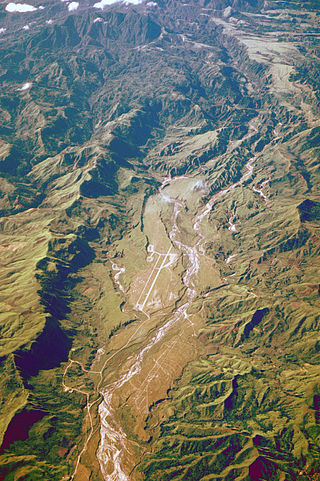
Colonel Ernesto Ravina Air Base (CERAB) or Crow Valley Gunnery Range, and formerly the Tarlac Military Testing Ground, was the main bombing range of the United States Armed Forces in the western Pacific, and by the Armed Forces of the Philippines. It is located in Camp O'Donnell in Tarlac, Philippines. The 42-mile facility is located approximately 22 kilometers from Clark Air Base and is primarily used for aerial combat training, which include bombing and strafing practice, as well as ground unit maneuver and live fire exercises.

Camp O'Donnell is a current military base and former United States military reservation in the Philippines located on Luzon island in the municipality of Capas in Tarlac. It housed the Philippine Army's newly created 71st Division and after the Americans' return, a United States Army camp. During World War II, the reservation was used as a prisoner-of-war camp for Filipino and American soldiers captured by Japan during its successful invasion of the Philippines. About 60,000 Filipino and 9,000 Americans were housed at the camp. During the few months in 1942 that Camp O'Donnell was used as a prisoner-of-war camp, about 20,000 Filipinos and 1,500 Americans died there of disease, starvation, neglect, and brutality.
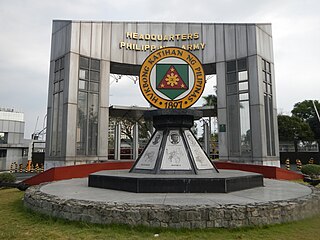
Fort Andres Bonifacio is the site of the national headquarters of the Philippine Army located in Taguig City, Philippines. The camp is named after Andres Bonifacio, the revolutionary leader of the Katipunan during the Philippine Revolution.
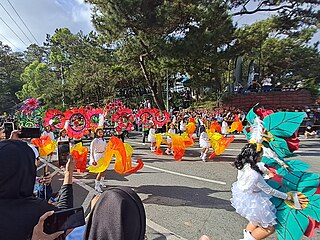
The Panagbenga Festival, also called the Baguio Flower Festival, is a month-long annual flower occasion in Baguio, Philippines. The festival, held in February, was created as a tribute to the city's flowers and as a way to rise from devastation of the 1990 Luzon earthquake. The festival includes floats that are covered mostly with flowers. The festival also includes street dancing, presented by dancers clad in flower-inspired costumes, that is inspired by the Bendian, an Ibaloi dance of celebration that came from the Cordilleras.

Clark, officially known as the Clark Freeport and Special Economic Zone (CFEZ), refers to an area in Central Luzon, Philippines.
Baguio City Economic Zone is a manufacturing special economic zone (MSEZ) located in the city of Baguio in the Cordillera Administrative Region. It is operated by the Philippine Economic Zone Authority (PEZA), an agency in charge of developing and operating special economic zones in the Philippines. It has a total area of 1,162,497 square metres (116.2497 ha) and 31 locators as of February 2024. As of 2021, the zone's biggest exports were radio, television and communication equipment; and transport equipment.

The Battle of Baguio occurred between 21 February and 26 April 1945 and was part of the greater Luzon campaign during the Allied liberation of the Philippines at the end of World War II. During the battle, American and Philippine forces recaptured the city of Baguio on the island of Luzon from a Japanese occupation force. One of the last tank engagements of the Philippine campaign took place during the battle. Baguio later became the scene of the final surrender of Japanese forces in the Philippines in September 1945.

The Bases Conversion and Development Authority is a government-owned and controlled corporation under the Office of the President of the Philippines. It is a government instrumentality vested with corporate powers under Republic Act 7227, signed into law by former President Corazon C. Aquino on March 13, 1992. The BCDA Charter was as amended by RA 7917 in 1995, and further amended by RA 9400 in 2007. The corporation is mandated to transform former US military bases into alternative productive civilian use.

New Clark City is a planned community currently undergoing development, located within the Clark Special Economic Zone in the towns of Bamban and Capas in Tarlac province, Philippines. It has an area of approximately 9,450 hectares and will accommodate up to 1.2 million people. It is owned and managed by the Bases Conversion and Development Authority (BCDA).

Fort Bonifacio is one of the 38 barangays of Taguig City, Philippines. The financial district of Bonifacio Global City, the Fort Bonifacio military camp and the Manila American Cemetery are under the jurisdiction of the barangay.

Vivencio "Vince" Bringas Dizon is a Filipino economist, consultant and political aide who previously served as president and CEO of the Bases Conversion and Development Authority. He also served as President Rodrigo Duterte's Adviser on Flagship Programs and Projects and as Deputy Chief Implementer of the National Action Plan Against COVID-19.

Camp General Servillano S. Aquino is a military base in Tarlac City, Philippines.
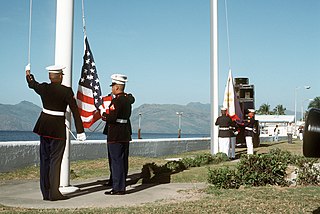
United States military bases were established in the Philippines on the basis of a treaty signed after the conclusion of World War II and the recognition of Philippine independence by the US. The bases established under that treaty were discontinued in 1991 and 1992, after the senate of the Philippines narrowly rejected a new treaty which would have allowed some of the bases to continue for another ten years. This article summarizes the collective history of those bases.




